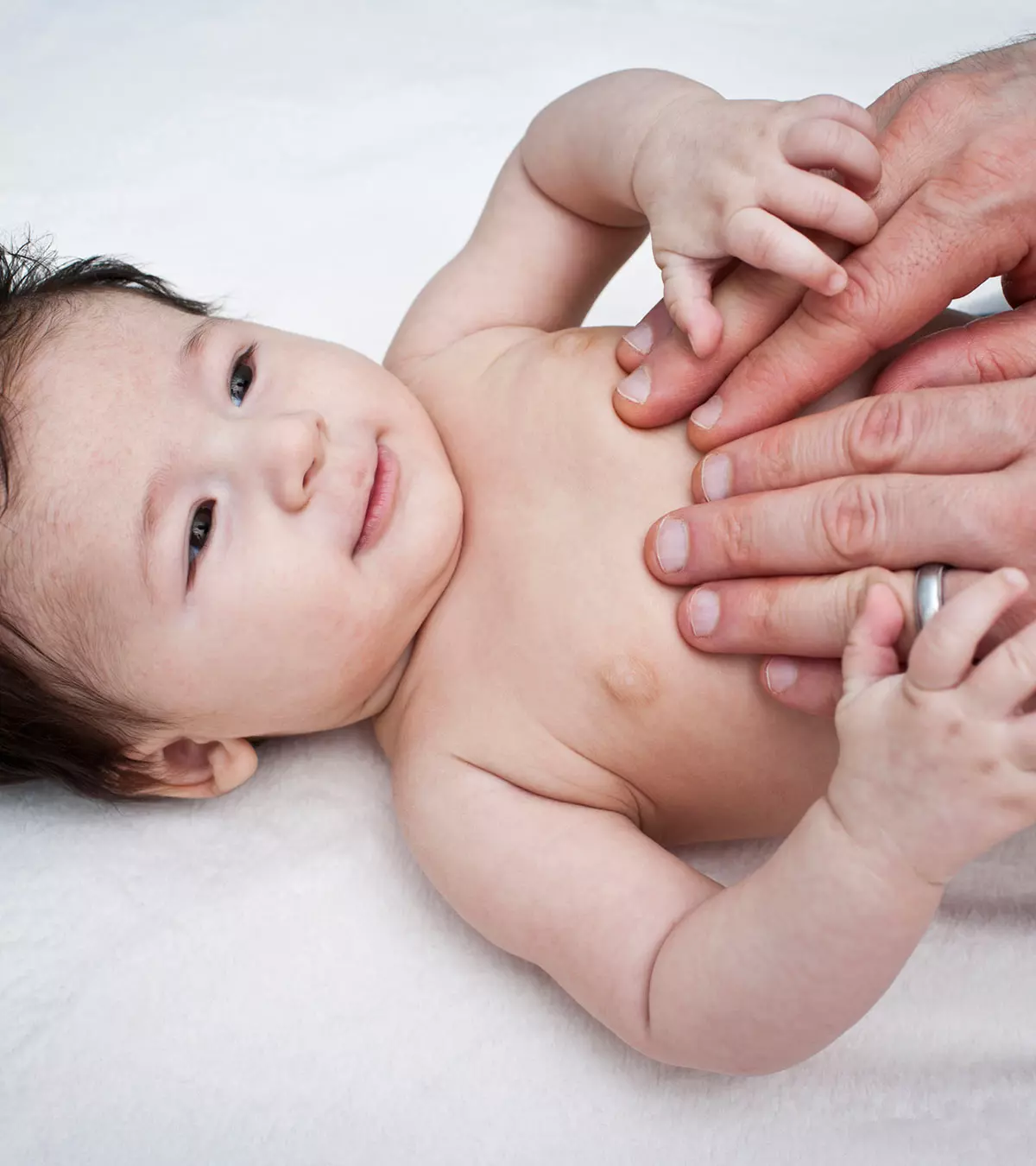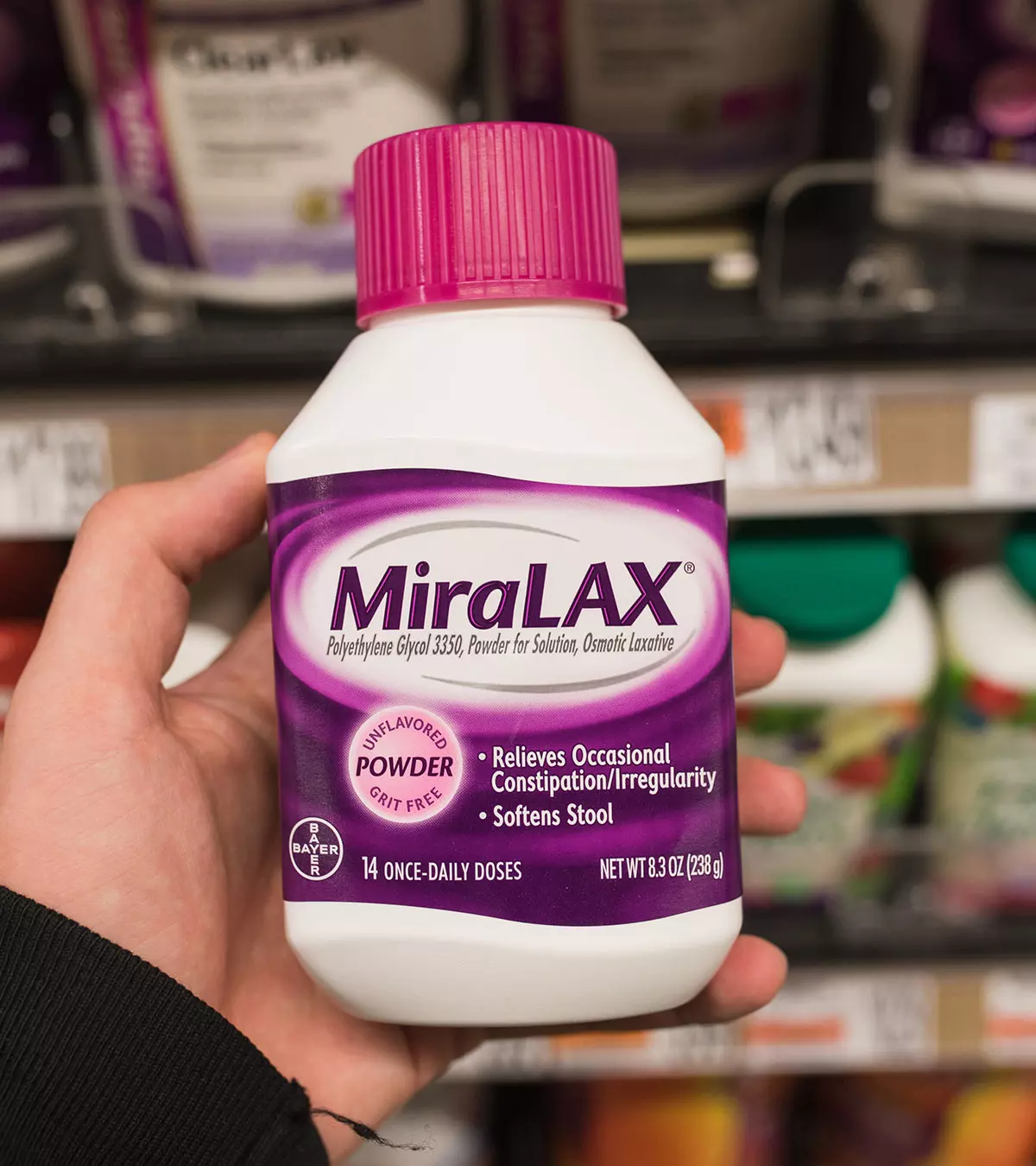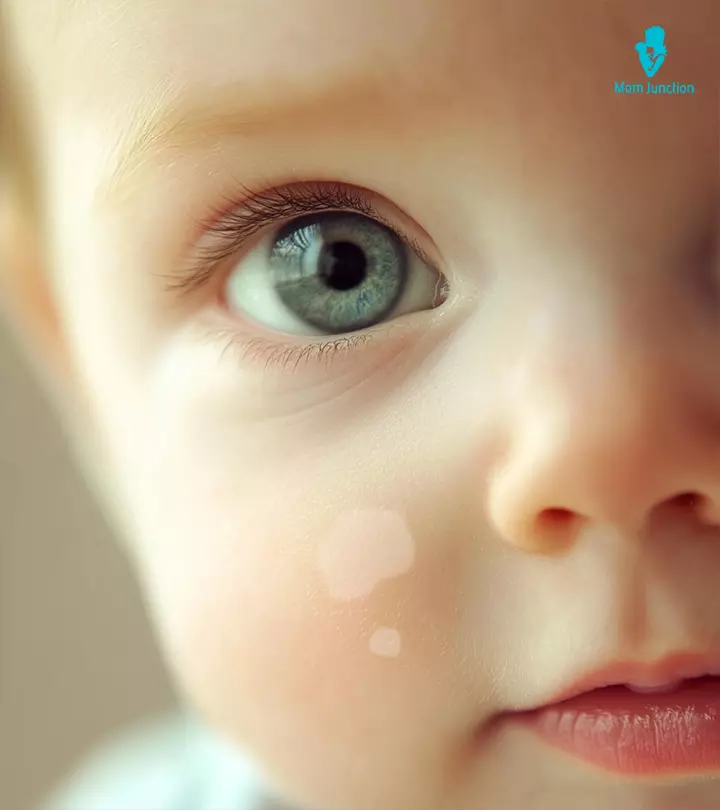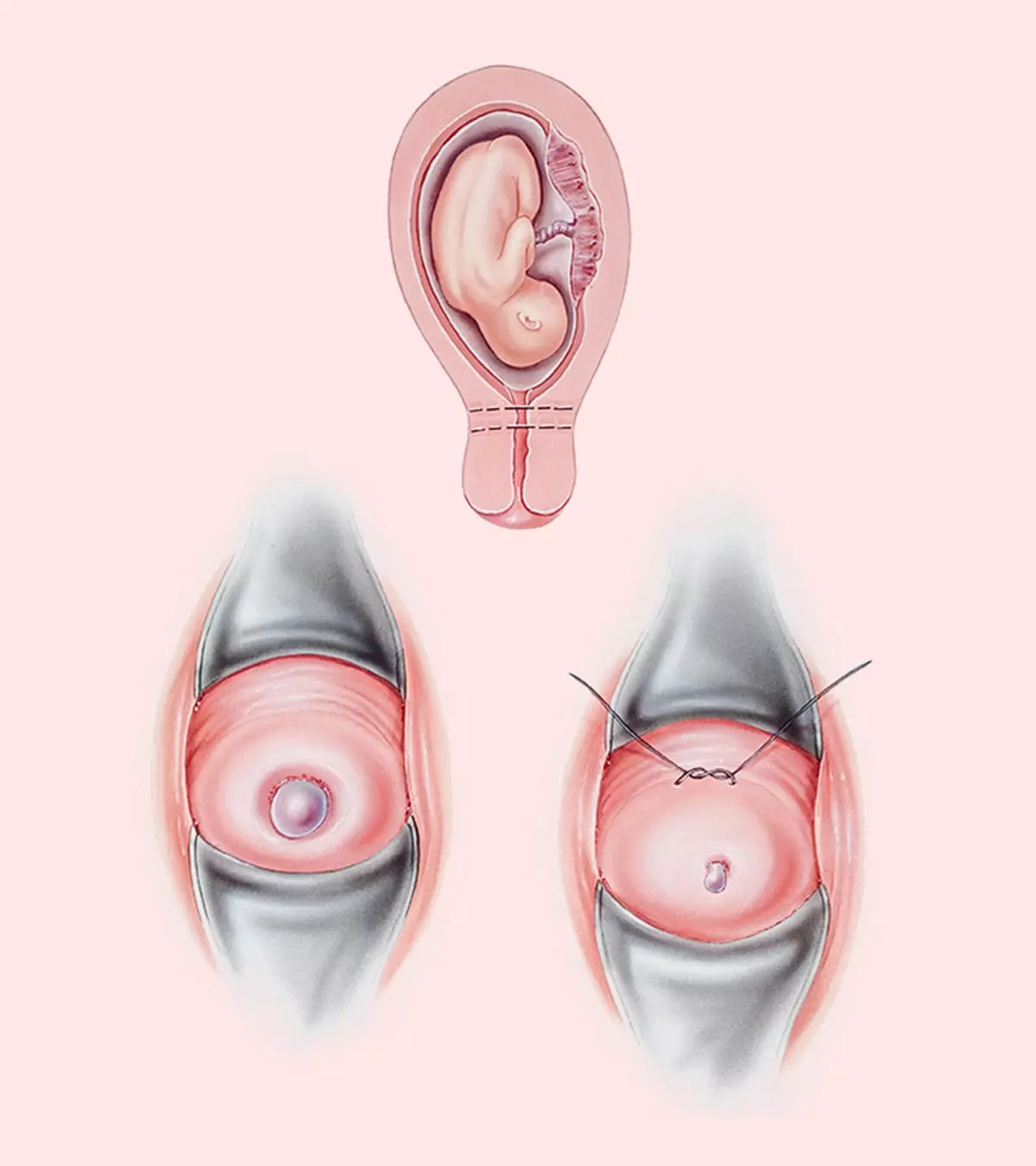
Image: ShutterStock
Birthmarks in babies may be of different types, shapes, and sizes. Therefore, they are usually considered unique identification marks. Some birthmarks are common and may be seen in many babies, while others are unusual and less frequently seen. Usually, birthmarks are not a dermatological condition that can cause concern, but some may be harmful. Therefore, it is important to consult a doctor if you find some worrisome changes in your baby’s birthmarks. Treatment strategies depend on their types and the health problems they may develop. Read about the types of birthmarks in babies, their causes, and ways to identify the risky ones.

Key Pointers
- Birthmarks are present by birth or appear shortly after as skin anomalies.
- Vascular birthmarks appear as purple, pink, or red marks and are caused by abnormal blood vessel formation.
- Pigmented birthmarks appear as light to dark brown marks and result from clumping of skin cells that produce pigment.
- Birthmarks are generally not concerning, but some can be harmful.
- Any changes in a birthmark should prompt a consultation with a doctor.
What Causes Birthmarks?
A birthmark is an anomaly in the skin, present from the birth, although some seem to develop soon afterward (1). Birthmarks are usually colored and are spontaneous anomalies. However, they may also be inherited or genetic.
Birthmarks are a type of skin pigmentation which are broadly classified into two categories (2):
- Vascular birthmarks: The heart and blood vessels comprise the vascular system, also called the circulatory system. Vascular birthmarks occur when blood vessels beneath the skin fail to form correctly or abnormally clump together under the skin. Despite this, they are not classified as a birth defect. These birthmarks appear as pink, purple, or red patches on the skin.
- Pigmented birthmarks: The skin contains cells called melanocytes or pigment cells, which produce the skin pigment melanin. When melanocytes group together in large amounts, this leads to the formation of pigmented birthmarks. These birthmarks are light to dark brown.
There are six types of birthmarks, and each of them falls under one of the two categories.
What Types Of Birthmarks Can A Baby Have?
There are three types of vascular and pigmented birthmarks each, which can occur anywhere on the body (3) (4):
Vascular Birthmarks
A non-cancerous lesion or anomaly caused by an abnormal formation or growth of blood vessels. These may be raised or flat, depending on the type.
1. Salmon patches

- These are pale to dark pink, or red, flat patches. They can appear anywhere on the face, mainly on the forehead, back of the neck, or the eyelids. They are called salmon patches because the color of the birthmark is similar to the color of the salmon fish.
- The patches do not have a defined border and often become prominent when the baby cries, sweats, or feels flushed due to increased blood circulation in that area.
- Medically referred to as Nevus Simplex, Salmon patches are colloquially called “angel’s kiss” when they appear on the forehead and “stork bites” when they are on the neck. Stork bite birthmark is a common birthmark type and affects a large percentage of newborns.
- Salmon patches are the most common vascular birthmarks and occur in one out of three infants. In some cases, they may fade away as the baby grows older.
2. Hemangioma

- Hemangiomas are benign tumors made up of blood vessels. They have many types and can occur throughout the body, including in the skin.
- A hemangioma appears as bright red or pink lesions on the surface of the skin. This birthmark is also called strawberry hemangioma due to its bright red color.
- It is soft and compressible, and doesn’t hurt when you press gently with a finger.
- Sometimes, the hemangioma may occur a little deeper below the surface of the skin, in which case it may appear more blue or purple. Hemangioma could be deep, superficial or mixed hemangioma.
- Hemangiomas usually grow initially but then shrink as the baby ages. It eventually disappears by the time the child is 7-10 years and may leave only a faint mark on the skin once where it existed. According to the American Academy of Ophthalmology, 90% of hemangiomas among children disappear by the age of nine.
3. Port wine stain

- Clinically called nevus flammeus, this type of birthmark appears as a flat, purple, reddish-pink to dark pink patch.
- These birthmarks are the color of wine or grape juice, which gives them their name. Port wine stains sometimes resemble salmon patches in color. The major difference between the two is that the port wine stain has a well-defined border and remains the same color, even when a baby cries or is flushed. These birthmarks usually do not fade and may even grow larger as the baby grows. They become more noticeable after the child attains puberty. Port wine stains in babies are rare and happen in less than 1% of infants (5).
Jena, a mother of three, shares how her son Elliot was diagnosed with a facial port wine stain. She shares, “I pushed hard to get him out, and he was all shades of red… However, I’ll never forget my mom in the background asking the nurse what was on his face. The nurse wasn’t sure herself; she said either bruising or a ‘mark.’ I remember my mom coming over with the baby and telling me that the nurse said it might be a ‘mark,’ but it may just be bruising… That evening, the pediatric nurse came in and took Elliot down for his check-up. When she brought him back, she confirmed that the ‘mark’ on his face was a port wine stain, which we later discovered is hereditary, and my mom has one on her side (i).”
Pigmented Birthmarks
These are skin markings caused by an overgrowth of melanocytes (or the pigment-producing cells in the body). Their color, shape, and size may vary depending on the type and the location.
1. Moles

- These are perhaps the most common types of birthmarks in infants. The medical term for a mole is a congenital melanocytic nevus.
- Moles come in several shapes, sizes, and colors. A mole can be large and flat or small or raised. They can be brown, black, tan, or pink (6).
- Existing moles may disappear as the baby grows older, while new ones may appear anywhere later. Moles can grow big and can have a diameter ranging between 1.5cm (0.6in) to more than 20cm (7.9in).
- Moles could become darker and bumpier during puberty.
 Did you know?
Did you know?2. Café-au-lait spot
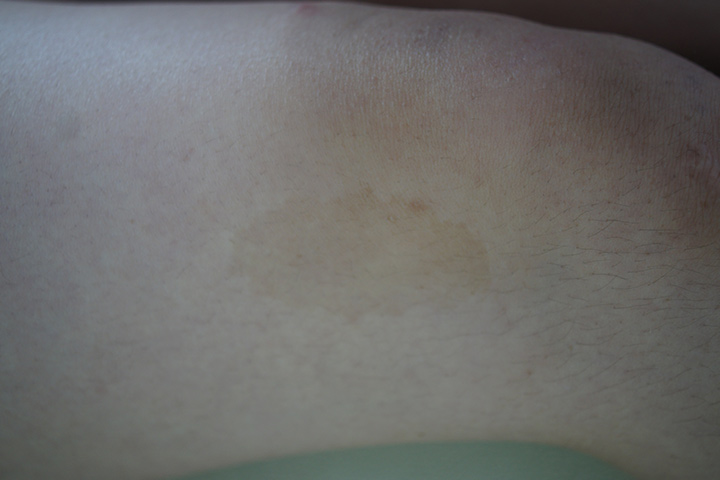
- Pronounced “cafay oh lay”, which is French for “coffee with milk,”. These marks that appear like skin discoloration get the name from their color, which is light to medium brown, like that of milky coffee.
- These birthmarks can appear anywhere on the body and may or may not fade away as the baby grows older.
3. Mongolian spots

- These are grayish-blue spots that look like bruises. They are called Mongolian blue spots since the Mongols were considered to have them initially. Nevertheless, these birthmarks are most common among Asians, Hispanics, Native Americans, and Africans (7).
- The Mongolian spots usually appear on the lower back, buttocks, and limbs.
- This type of birthmark may fade as the child grows older, although in some it may persist for longer, even growing darker as the baby ages.
 Did you know?
Did you know?Can Birthmarks Be Dangerous For A Baby?
Birthmarks are cutaneous abnormalities that are usually not harmful. But in some instances, a birthmark could be a cause for concern:
- More than six café-au-lait spots: Many babies have one or more café-au-lait spots. However, if they have more than six, this could be a clue that the child has neurofibromatosis, which is a benign tumor of the nerve cells. Babies with many cafe au lait spots should see a doctor for further examination (19).
- Hemangioma near the eye, ear, or throat: A strawberry hemangioma on the face may interfere with visual development, hearing development or may just be disfiguring. Facial hemangiomas may need to be treated in order to prevent these problems from occurring. Hemangiomas that occur in the airways can also cause breathing problems and need to be watched carefully.
- Ulcerated hemangiomas: Certain hemangiomas may develop a wound or sore, making them more painful. When located around vital body areas such as the genitalia or mouth, these may interfere with their functioning. Children with ulcerated hemangiomas require timely diagnosis and treatment to live a quality life (20).
- Multiple hemangiomas. Babies with multiple hemangiomas may have an increased risk of having hemangiomas occurring in the internal organs, especially the liver. Babies with large hemangiomas, or more than five hemangiomas, should be carefully examined or referred to a specialist
- Port wine stain on the eyelid: Sturge Weber syndrome (SWS) is a congenital condition. Babies with SWS are often born with a port wine stain on the face, forehead or eyelid. SWS may be associated with several neurological and visual problems and children with this condition should be referred to a specialist (8).
- Rapidly growing mole: If the mole grows rapidly and becomes darker, then it could be a symptom of skin cancer. Although this is unusual for birthmarks it is still vital for parents to keep an eye on the size of the baby’s mole.
- If you notice any of the symptoms mentioned above or if a birthmark itches, bleeds, or becomes painful, then take your baby to a doctor.
How Are Dangerous Birthmarks Diagnosed?
Clinical examination of the baby can determine whether or not a birthmark is harmful. Birthmarks are usually checked during well-baby check-ups. If you notice anything unusual with your child’s birthmark, make an appointment to see your doctor. Early detection of such unusual birthmarks may aid in timely treatment and recovery.
Furthermore, early detection and treatment may also help in reducing the psychological impact that birthmarks leave on the child’s self-esteem as they grow up. Studies indicate that the intensity of this impact may depend on the size, texture, shape, color, and location of the birthmark. Facial birthmarks such as port wine stains or infantile hemangiomas tend to affect the child’s caregiver and peer bonding due to bullying and social isolation at school. However, the same study proves that early intervention can have a significant impact on the child’s self-esteem and bonding with caregivers and peers (19) (21).
Do Birthmarks Need To Be Treated?
Most birthmarks will not require any treatment. If the birthmark does not pose a health problem to the baby or cause any discomfort, then its removal would be purely for cosmetic reasons. Your baby’s doctor can let you know about the pros and cons of doing the surgery in such a case.
If the birthmark is causing health problems then it might be necessary to treat. Different types of birthmarks require different approaches. A specialist will decide if the birthmark should be removed surgically, treated with laser treatment or can be treated with oral or topical medication. However, surgical removal may pose risks for infections and scarring, which parents may not prefer in cases where the birthmark is relatively benign. In cosmetic cases, alternatives such as cryotherapy (freezing and removing unwanted tissues) or cortisone injections may also be suggested to treat the birthmarks.
However, unless the condition is life-threatening, doctors may prefer to wait for the child to grow as old as six years to perform removal procedures (19).
 Point to consider
Point to considerShould Birthmarks Be Removed?
Birthmarks may not necessarily require removal unless they affect the baby’s health or sensorimotor development. A doctor may also perform a procedure if parents wish to remove the birthmark for cosmetic reasons. In either case, the following procedures would be employed to get rid of the birthmark:
- Surgical removal: Birthmarks like hemangioma, which compress against internal organs and cause discomfort, are surgically removed. Surgery is done only after assessing how the birthmark impacts the health of the baby. If surgery is deemed necessary, the procedure will be done in a way that minimizes scarring and does not create additional skin lesions or damage.
- Laser treatment: A laser treatment is used to reduce the intensity of the birthmark’s color and is not recommended if the mark is harmless. This procedure can be useful for lightning port wine stains and Mongolian spots. Laser treatment requires adequate preparation, and the baby will have to be admitted to the hospital as the surgery is performed under general anesthesia (9).
Laser surgery also poses risks and possible side effects such as the onset of pain, scarring, discoloration, and infection at the site of the operation (10). The treated area will also be sore for up to eight hours after the therapy and would require extensive post-operative care.
- Steroid treatment: Oral or injected steroids can help bring down the intensity of the birthmark. This treatment is usually suggested in the case of hemangioma. However, steroids can have side effects and studies have shown that 40% of hemangioma treated with steroids often rebound and reappear (11). Steroids can be used as a last resort or as part of a systemic birthmark treatment that encompasses other treatment methods.
- Beta-Blockers: A group of medicines called beta-blockers is found to be effective against hemangioma birthmarks (12). The beta-blocker propranolol can normalize the abnormal blood vessels of a strawberry hemangioma in the baby. The medicine has fewer side effects than steroids and can be chosen as a method to get rid of the birthmark without surgery. A doctor may prescribe the medicine if steroids are not an option or if the birthmark cannot be surgically removed.
- Radiation therapy: If a mole or café-au-lait is cancerous, then the doctor may suggest radiation to subdue it.
Frequently Asked Questions
1. Can brown birthmarks be removed?
Removal of brown birthmarks (light or dark) depends on their location, type, and size. Some marks might develop at the time of birth, while some could appear later. However, if you want to get rid of a brown birthmark, your doctor could advise you on either laser treatment or a surgical excision after proper evaluation (13).
2. How do I get rid of birthmarks on my baby’s face?
Strawberry hemangioma and port wine stains are the most common birthmarks on a baby’s face. If your pediatrician suspects these stains might cause problems, they may suggest laser therapy to remove the birthmark on the face. Although laser therapy is effective in lightening the marks, it might not completely erase them in some cases (14).
3. Are birthmarks dominant or recessive?
While most birthmarks occur sporadically, hemangiomas and vascular malformations have been noted to have an autosomal dominant trait that occurs through inheritance, with no variation amongst its occurrence in boys and girls (16) (17).
4. Can my child and I have the same birthmark?
Studies suggest genetic material is responsible for the familial inheritance of certain birthmarks but not all (18).
Birthmarks in babies can be vascular or pigmented, and they rarely cause health problems. Even if there are visible traces on the skin, your baby can continue with their daily routine. If the birthmark isn’t bothering the baby or causing discomfort, it can be removed only for cosmetic reasons. However, a birthmark can be dangerous for a baby if it is more than six café-au-lait spots, hemangiomas, or rapidly growing mole, requiring medical attention. In either case, your baby’s doctor can advise you on the benefits and drawbacks of surgery.
Infographic: Different Types Of Birthmarks In Infants
Birthmarks are harmless, appear soon after the baby’s birth, and usually do not require any treatment. Nevertheless, monitor birthmarks and consult with a doctor if they change in size, shape, or color or if they are causing discomfort to your baby. This infographic lists the most prevalent birthmarks in infants.
Some thing wrong with infographic shortcode. please verify shortcode syntax
Illustration: Birthmarks In Babies: Causes Types And Treatment

Image: Stable Diffusion/MomJunction Design Team
Learn about the causes and possible treatments for baby birthmarks. Experts will provide you with useful advice on how to properly care for your baby and handle any birthmark queries.
Personal Experience: Source
MomJunction articles include first-hand experiences to provide you with better insights through real-life narratives. Here are the sources of personal accounts referenced in this article.
i. The beginning of our journey.https://elliotspwsjourney.blogspot.com/2011/
References
- Birthmarks.
https://www.nhs.uk/conditions/birthmarks/ - Birthmarks.
https://medlineplus.gov/birthmarks.html - How to treat diaper rash.
https://www.aad.org/public/everyday-care/itchy-skin/rash/treat-diaper-rash - Vascular Birthmarks.
https://www.health.harvard.edu/a_to_z/vascular-birthmarks-a-to-z - Port wine stains.
https://www.rch.org.au/kidsinfo/fact_sheets/Port_wine_stains/ - What is a pigmented birthmark?
https://www.northwell.edu/plastic-surgery/procedures/treatment-of-pigmented-birthmarks - Dermal melanocytosis.
https://medlineplus.gov/ency/article/001472.htm - Sturge-Weber syndrome.
https://medlineplus.gov/genetics/condition/sturge-weber-syndrome/ - Pulsed Dye Laser Treatment.
https://www.chp.edu/our-services/plastic-surgery/patient-procedures - Laser Therapy for Birthmarks.
https://www.asds.net/skin-experts/skin-treatments/laser-light-therapy/laser-therapy-for-birthmarks - Hariharasubramony Ambika et al.; (2013); Topical Timolol: A Safer Alternative for Complicated and Un-Complicated Infantile Hemangiomas.
https://www.ncbi.nlm.nih.gov/pmc/articles/PMC3726918/ - Harrison P. Nguyen et al.; (2014); Beta-Blockers as Therapy for Infantile Hemangiomas.
https://www.ncbi.nlm.nih.gov/pmc/articles/PMC4078206/ - Brown Pigmented Birthmarks
https://www.nbt.nhs.uk/bristol-laser-centre/laser-treatments/brown-pigmented-birthmarks - Baby Birthmarks & Rashes
https://www.healthychildren.org/English/ages-stages/baby/bathing-skin-care/Pages/Your-Newborns-Skin-Birthmarks-and-Rashes.aspx - Birthmarks in Infants.
https://www.hopkinsmedicine.org/health/conditions-and-diseases/birthmarks-in-infants - Ben Pocock et al.; (2006); Molecular Basis of Vascular Birthmarks.
https://www.ncbi.nlm.nih.gov/pmc/articles/PMC2884761/#:~:text=Some%20vascular%20birthmarks%20have%20been,in%20an%20autosomal%20dominant%20manner - Vascular Malformations and Hemangiomas.
https://www.nationwidechildrens.org/conditions/health-library/vascular-malformations-and-hemangiomas - Birthmarks.
https://www.betterhealth.vic.gov.au/health/conditionsandtreatments/birthmarks - Birthmarks.
https://my.clevelandclinic.org/health/diseases/12159-birthmarks - Infantile Hemangioma.
https://www.hopkinsmedicine.org/health/conditions-and-diseases/infantile-hemangioma - K.L. Vivar and L. Kruse; (2018); The impact of pediatric skin disease on self-esteem.
https://www.sciencedirect.com/science/article/pii/S235264751730093X#:~:text=In%20a%20study%20of%2071,et%20al.%2C%201998)
Community Experiences
Join the conversation and become a part of our nurturing community! Share your stories, experiences, and insights to connect with fellow parents.
Read full bio of Dr Sarah Jane Karabus
Read full bio of Rohit Garoo
Read full bio of Dr. Ritika Shah
Read full bio of Shinta Liz Sunny











